|
Reviewing the
Reviewers
What are the best CD and music guides now in print?
by Tim McMahan
|
Take one look at
MTV's Matt Pinfield and you can tell that he couldn't possibly be as
smart as he appears hosting 120 Minutes, MTV's Sunday night hommage to
alternative music. How does ol' baldy know all that obscure music trivia right off the top
of his shiny head? Well, in addition to being relatively brilliant and having MTV's entire
research staff at his disposal, Pinfield, just like hundreds of know-it-all music
reviewers around the country, relies on CD guides and "music encyclopedias" to
help him look so damn smart. There are dozens of music guides in print. These rock
encyclopedias recap a band's history, describe their sound and recommend the best
releases. But in addition to being great reference sources, CD guides are a blast to read.
Those with even a passing interest in rock music will find reading guides as addictive as
eating potato chips. Once you look up one artist's catalogue, you're drawn to another,
then another and another, and before you know it, you've been reading for a couple hours.
You'll also be frustrated by the inconsistency of the ratings and reviews. A CD you've
always thought sucked will get a rave, while one of your favorites will rate only two
stars.
The following is a brief look at some of the best rock music guides in print. Although
almost all list the most popular artists of the day, how good is a guide if it doesn't
include your favorite band? For rating purposes, 15 artists were randomly selected, then
each guide was checked to see if it included their entries. The Obscurity
Rating reflects how well each guide did, so if a guide listed five of the
15, it received an Obscurity Rating of 33 percent.
The 15 artists: Yo La Tengo, Liz Phair, Superchunk, Fugazi, Timbuk 3,
Windbreakers, Hunters & Collectors, The Muffs, Red House Painters, Jon Spencer Blues
Explosion, Lloyd Cole, Bob Mould, Psychedelic Furs, The Tubes, Black Flag.
Also included is an overall 5-star rating for each guide.
|
 |
|
All Music Guide to Rock Miller
Freeman Books, 1997
1,800+ musicians indexed, 1,232 pages
$26.95
Uses a 5-star rating system
Obscurity rating: 93 percent
Overall rating:
The be all and end all of rock music guides,
"All Music" takes into account the bumbling idiot novice who just discovered The
Byrds, Hanson, Neil Young or Del
Shannon, right along with the fan looking for more info about Pete
Shelley, The Residents, Kula Shaker or Guided
by Voices. Well-balanced, comprehensive bios include all the pertinent facts,
such as date of birth/date formed, highlights, lowlights and ultimate break-ups. With a
heavy emphasis on rock - both mainstream and alternative - the guide also lists rap, pop,
soul and R&B artists.
On the downside, the guide's writing can be rather dry, and the typefont size is
eye-strainingly small. CD listings aren't comprehensive, listing only reviews and ratings
of "the best releases." So much for discovering a lost gem, though in its
defense, the guide really only leaves out the real stinkos.
All Music also includes genre essays, where you can discover the difference between Doo
Wap and Rockabilly; girls groups and the Stax/Volt sound.
If you buy only one music guide as a general resource, this one's hard to beat. Even
the most die-hard alternative music fans will be reasonably satisfied with the listings.
Along with the Trouser Press guide (below), it's the only guide that's always at my
fingertips.
|
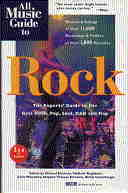 |
| The Trouser Press Guide to '90s
Rock
Edited by Ira A. Robbins
Fireside/Simon & Shuster, 1997
2,300 musicians, 846 pages
$24.95
No rating system
Obscurity rating: 80 percent
Overall rating: 
The favorite among the alt/punk/indie/college
rockers, this edition, along with Trouser Press' fourth edition Record Guide, is the
ultimate definer of indie music obscura. For sheer entertainment value, flip through and
try to find the most bizarre band name: Algebra Suicide, Ovarian
Trolley, Stigmata A Go Go, Stinky Puffs, Gobblehoof?
My pick: Armageddon Dildos. Just about every alternative band is listed
that released a recording on a known label before 1997. Trouser is the only guide where
you could find a comprehensive listing of all the Sidewinders' releases, as well as
listings for local bands such as For Against and Mercy Rule.
The Trouser guide does include some mainstream listings, mostly by recent popsters who
have been miscatagorized as "alternative," such as Blues Traveler,
Sting, Dave Matthews Band, etc. But the real emphasis
here is on the punk/alt scene (you won't find listings for Led Zeppelin, Pink
Floyd or Van Halen).
The band bios are better written -- and feistier -- than those in the All Music Guide,
and even include rarely spoken tidbits (such as Pantera's efforts to
cover up their brush with glam-metal, which if mentioned in their presence, could result
in bodily harm). The Trouser Guide reads more like a good magazine than an encyclopedia.
On the downside: No rating system, which forces you to read an entire entry to find the
writer's picks. There's also no index. Regardless, this is easily my favorite, and most
useful, reference source.
|
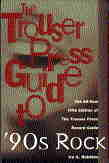
|
|
|
SPIN Alternative Record Guide
Edited by Eric Weisbard and Craig Marks
Vintage, Oct. 1995
468 pages, indexed
$20
10-point rating system
Obscurity rating: 53 percent
Overall rating: 
The colorful, large-format paperback is more of
an extended "best of" listing by SPIN than a comprehensive guide. The editors
don't hide that fact, boasting that it includes only "the essential artists and
albums of punk, new wave, indie rock and hip hop." So much for Night Ranger.
Only the A-list of college music is represented. Most artists have been heard on
commercial alternative radio stations or MTV. The short, glammy bios are written in the
same pretentious, poseur style that has made SPIN both loved and hated by music fans for
years. With limited listings, the emphasis is on "important bands" and
commercial success. Hence, your favorite band may not be listed because it's not one of
SPIN's favorites (or a potential SPIN advertiser).
On the plus side, the 1-to-10 rating system, attractive readable design, photos of
album covers, all make for a nice coffee table book. After the first read-through, I've
never opened this one again. Also includes SPIN's list of Top 100 alternative albums (No.
1: The Ramones' first album; No. 100: Sex Pistols,
"Never Mind the Bollocks, Here's the Sex Pistols").
|


|
| Rolling Stone Album Guide
Edited by Anthony DeCurtis and James Henke
Random House, 1992
838 pages
$20
5-star rating system
Obscurity rating: 40 percent
Overall rating: 
Isn't Rolling Stone suppose to be the definitive
source for all things rock 'n' roll? You couldn't tell by reading this rather lame music
guide. In its defense, no where does it say that the guide contains reference for
alternative or underground music. Instead, you get bios of popular artists and consistent
ratings of their available catalog.
That's not to say there isn't any alternative bands listed. Nirvana's
included, as is Poi Dog Pondering, Camper Van Beethoven,
Husker Du and quite a few "new wave" artists and '80s indie
darlings. But indie/alt is not the bread-and-butter of this guide. This is where to go to
find ratings for 35 Rolling Stones albums, every classic Pink Floyd CD,
or ratings for such by-gone groups as the Ohio Players and Irene
Cara (called here "a mediocre Donna Summer
impersonator"). The bios are relatively comprehensive without overwhelming readers
with minute details. And Rolling Stone has always boasted top-notch writers, which means
you're in for a pretty good read.
On the downside: No index and only fleeting references to grunge. This is the guide for
classic rock, mainstream and oldies lovers who have little interest in alternative music.
|
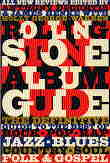

Ohio Players circa 1974
|
|
|
Christgau's Record Guide The '80s
Robert Christgau
Pantheon, 1990
3,000 CDs reviewed, 514 pages
$17.95
Alpha grading system
Obscurity rating: 53 percent
Overall rating: 
Worth mentioning because it has the most lively
-- and funny -- writing of the bunch. Christgau, a reviewer at the Village Voice, never
minces words. He crams each of these 3,000 capsule reviews with every ounce of his
personality. A taste from the review of Frankie Goes to Hollywood's
"Welcome to the Pleasuredome":
"'Relax' has proven itself a fetching fuck-mantra, 'Two Tribes' is
fair-to-middling political art. But on the whole, Frankie are a marginally competent
arena-rock band who don't know how to distinguish between effeminacy and pretension, like
an English Grand Funk gone disco…"
This is one guide you'll read cover-to-cover, if only to catch all of Christgau's
clever one-liners. There's not a dull review in the bunch, even for the bands you've never
heard of. The guide also contains his "core collection" of pre-1980 recordings
and a listing of all CDs that received an "A" rating.
Also still available is Christgau's Record Guide The '70s. Let's hope there's a guide
to '90s rock printed next year.
|
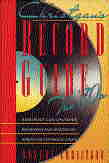
|
| Virgin Encyclopedia of Popular Music
Edited by Colin Lankin.
Virgin Books, 1997
3,000+ entries, indexed. 1,343 pages
$35
5-star rating system
Obscurity rating: 40 percent
Overall rating: 
One look and you'd think you've found the
ultimate music guide. The book is a huge, heavy, hardbound volume that's way too clumsy to
lug around. But looks can be deceiving. The guide's emphasis is on '70s and '80s pop music
- that means poor alternative listings - all written in a dry, lifeless style.
On the plus side, the artist bios contain a tremendous amount of detail, and the
ratings are inclusive - in other words, an artist's catalog is rated against its own
releases, so a Beatles record that fetches a 3-star rating is most likely
better than a Des O'Connor CD that rates three stars. The guide's '97
release date means there are some listings for recent acts such, as Ben Folds Five,
Fugees and Silverchair.
The big downer, though, is how the guide turns rock 'n' roll into an academic research
project. Where else would you find a listing for Spencer, Jon, Blues Explosion. This is
the kind of reference you would use to write a term paper, not an album review.
|

|
|
|
Rock - The Rough Guide
The Rough Guides, 1996
1,000 artists, 1,001 pages
$26.95
No rating system
Obscurity rating: 60 percent
Overall rating:
Another in the Rough Guide series that brought
you The Rough Guide travel series, Rough Guide to the Internet, as well as the Rough
Guides to Classical, Jazz, Opera, Reggae, and on and on. Developed via the Internet over a
year, the Rock Rough Guide "was written by fans" who apparently contributed
information on a website. The result is a mish-mash of band listings, all written with
love in the writer's heart. The bottom line: Reviewers are judged not only by what they
love, but also by what they hate. Purposely without balance, it's impossible to take any
of the criticism in this guide seriously.
In addition to being overtly fawning and gossipy, the guide only lists
"recommended" CDs, has ultra-brief bios, and includes hundreds of cheesy
photographs.
Back to 
Originally printed in The Reader February 11, 1999.
Copyright © 1999 Tim McMahan. All rights reserved.
|
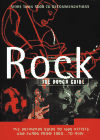
|
|

![]() webboard
interviews
webboard
interviews